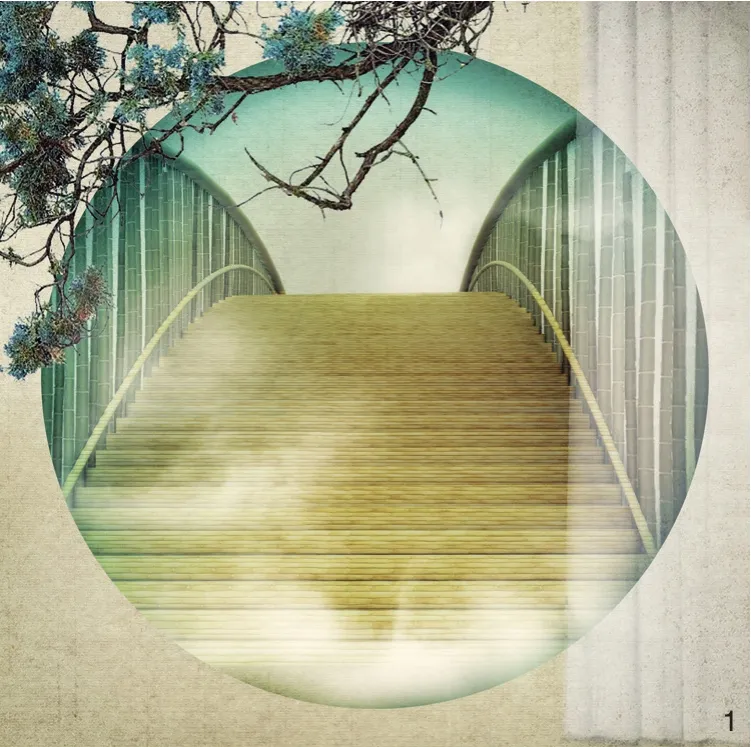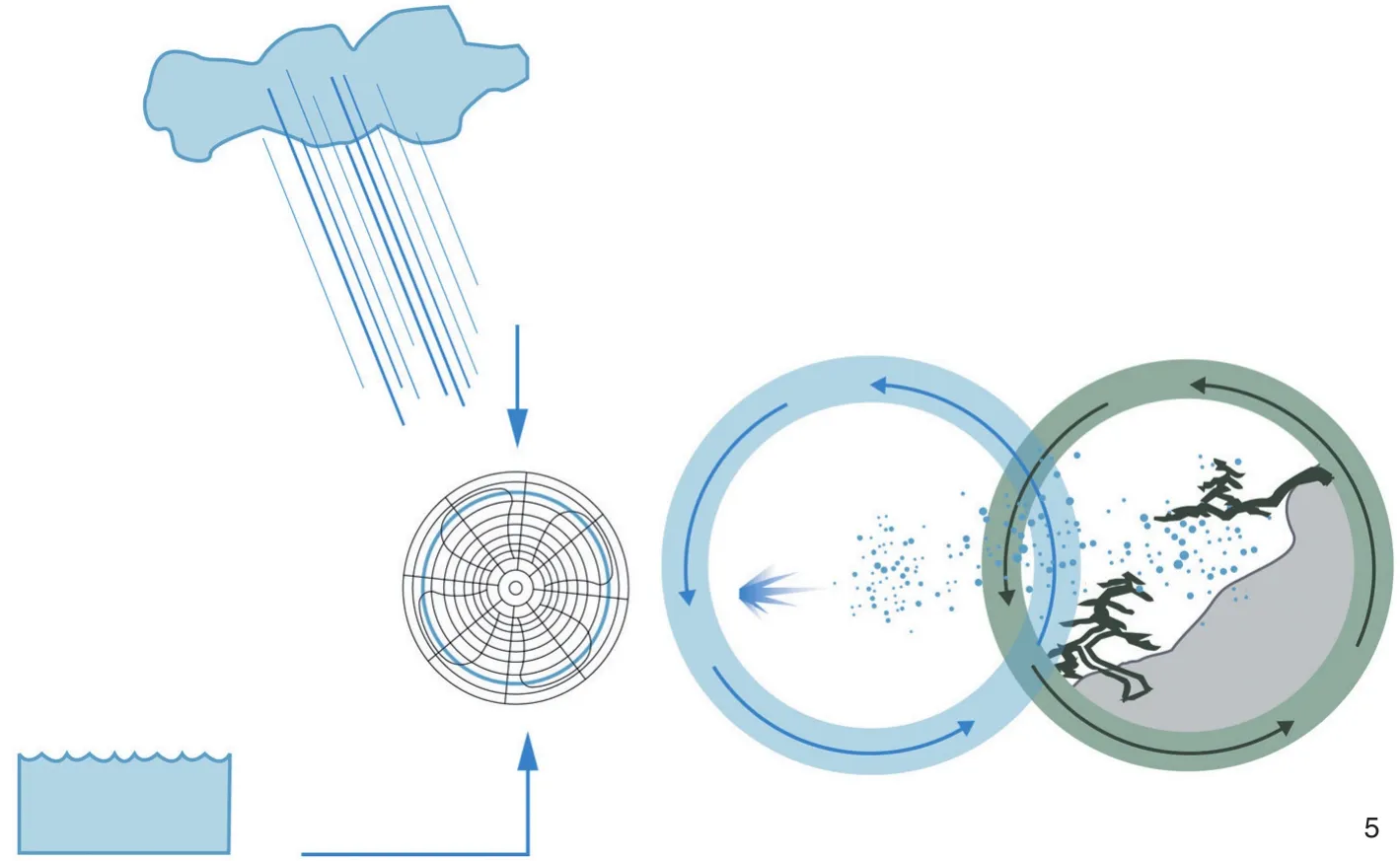园
(丹麦)斯蒂格·L·安德森
(编辑/ 西西莉亚·耶森·汉森 张雯娟)
Yuán,我们称之为新·园,是一个沉思和探索的空间。在这里,传统的中国文化和自然交融成为一个感性的糅合体。在一个难分自然文明和人类文化的时代,园想要去潜移默化地启发游客,对自然和人性关系进行探索和思考。
我希望通过园,强调人们对于自然的审美是一种感官的感受,这也是我在自己的工作中不断重现的。这种微妙的体验,这种漫游的感觉,就像是会发生在雾蒙蒙的早上,或者是走在树林里的小路,你会感觉到感官的释放,远远超出于凡世和理性的追求,而这种感觉我们在城市里很少体验到,甚至于我们没有感受到我们对其的渴望。
因此,我也希望让游人在我们的园中去发掘这些他们本来有的形而上的感官体验,这是种不自主地、潜意识地把自己放置于自然的能力,这种不是逻辑推演而是体验自己和自然丝毫互动的能力。通过这种能力去唤醒审美和感官,我们想要去创造一个景观,它并不存在于实体,而是与游人融合交流,让游人成为它的一部分,在其中去发现和思考。
中国文化和传统,将自然看作是一个富有哲学意味的概念和存在,自然哲学随着时间的演变而成长,形而上的概念融入了绘画和园林之中。论其中的感受,已远远超越了形而下的视和被视,无关乎自然的存在与否,而在于美和灵性的升华。这样微妙的体验,恰好揭示了对于文化和自然关系的探索。
因此,国画不在于形似,而在于意动。国画常常描绘水雾和留白,往往想要传达流动和空灵,营造出一个在潜意识中想象和升华的空间。

1 效果图“竹间”Moon Gate collage

2 效果图“峰壑”Bridge Top collage

3 效果图“幽翠”Bamboo Scaffolding collage
园将传统的中国自然哲学审美及其对人视角的抽象,代入其中。正如同国画和园林,园不在于其形,在于其意,意图创造出一个强调形而上的看与被看,感知精神世界。在这个人类驾驭自然的时代,人类社会的现代材料和技术被用于创造和维持,这是我们从中国传统中继承下来的关于美和自然的哲学。

4 效果图“松风”Bamboo Scaffolding Meandering collage
正如同国画中留白一般,园创造出一个空灵的意境。园将空间围合与隔离,在其中创造出飘忽流动的景观和意境,触发游人的感官,进行形而上的思考和探索。作为园的一部分,游人不仅仅“视”,而且“被视”。
在这个科技改变自然的时代,园不仅仅传承中国哲学的审美和人与自然的关系,同时容纳和适应这个科技社会所带来的层层变化,让游人能体验和经历传统中式哲学和美学在现代社会的继承和再现。
(编辑/ 西西莉亚·耶森·汉森 张雯娟)
项目设计:SLA事务所
翻译:刘书菡
The New Garden carries on this Chinese tradition for aesthetic contemplation of nature and its spiritual meaning. It does not do so by way of representation, but by creating a basis for experience itself, and thereby for a beginning understanding of the new nature. Elements from the classical Chinese landscape painting and garden are staged in a cultivated, man-made ecosystem where nature and culture merge to form a reality that defy traditional concepts. Here, modern technology is as much a part of the ecosystem as the pine tree, the water as much as the electrical fans that disperse it.
The New Garden is a space for rediscovery and contemplation. Here,ancient Chinese knowledge and a new nature are brought together in a sensuous presence. It invites visitors to intuitively reflect on the relationship between nature and humanity, in a time where they are increasingly hard to distinguish.
With The New Garden, I wish to make the aesthetic sense of nature present to visitors as a felt experience—an experience that guides me in my own work. It is the sense of wonder a misty morning can evoke, or the feeling of belonging during a forest walk. In a time where rationality and economic pursuit takes precedence, it is an experience that is increasingly absent in our cities and our individual lives. It leaves us unattuned to the world, its constant becoming and vitality, and with an elusive sense of longing.
I wish to invite visitors to rediscover their own innate ability to inhabit and relate to the world in an intuitive, sensuous way—to know it not just by way of logic and calculation, but by paying close attention. Through an awakening of an aesthetic awareness and a sensuous presence, visitors are invited to discover and contemplate the new nature, they themselves are part of. A nature not untouched by human hands, but one that is tangled,intertwined and changed.
Nature as both philosophical concept and experience has a long history in Chinese culture and tradition. A characteristic understanding of nature is expressed in both the classical Chinese landscape painting and garden. Both are an image not of the seen, but of the felt—they represent the experience of nature and the relationship between nature and humanity. As such, they illustrate a cultural attunement to the aesthetic rather than the material quality of nature.
The classical Chinese landscape painting does not strive to capture a precise visual representation. To the contrary, it illustrates the experience of being in and with the landscape and meditates on the aesthetic experience of nature. It often depicts a sea of fog or a void—an intangible space without solid shapes and de finite answers. A space for imagination and intuition, and for aesthetic attunement.
The New Garden incorporates the void from the classical landscape painting as an all-encompassing atmosphere. The garden envelops its inhabitants, both human and non-human, in a foggy and sensuous mist. Delaying visual certainty and enhancing the sensual presence in the garden, the fog creates a sphere for imagination and intuitive understanding. In the atmosphere, visitors become part of the garden, and their attention is directed as much towards their own presence as their surroundings.

5 概念分析图Process diagram

6 鸟瞰图Atmosphere Axonometric
Being at the same time both clearly staged and technological, and yet inherently real and present, The New Garden is a space to experience what nature might mean in our day and age. It asks its visitors how the aesthetic qualities of natural phenomena could be grasped in a time where their materiality and origin are changing.

